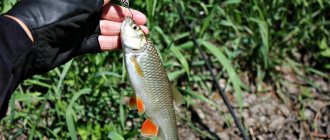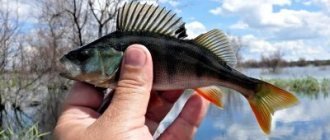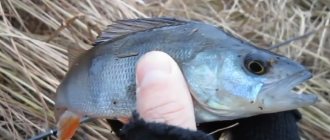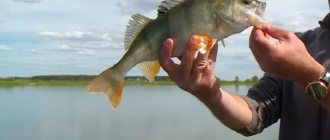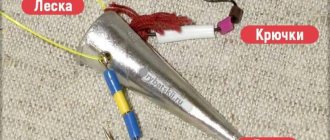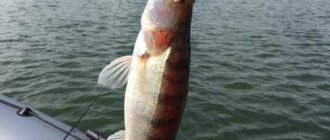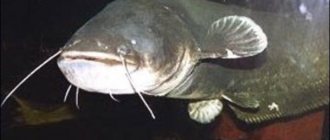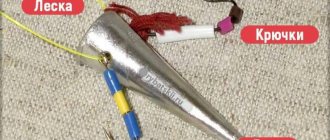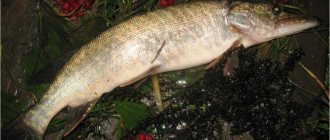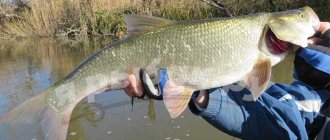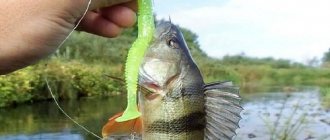Where to look for perch in autumn
The first task of any fish before a long and difficult period is to gain fat. This is exactly what perch does throughout the fall. Flocking into numerous flocks, he spends his day hunting. Constantly pursues young peaceful fish - the main and constant diet of the predator.
Where there is a school of white fish, all predatory fish, from small to large, are sure to be there. Do not forget that the real threat to all inhabitants of the reservoir is pike and pike perch. Therefore, places with natural shelters are the best for a spinning fisher: a striped fish can hide behind snags, bushes, flooded trees, and not yet completely fallen algae.
With each autumn month the weather becomes harsher, temperature, pressure, wind change - all this dictates its own rules. Below we will look at where the fish will most often stand depending on the time.
September
Perch continues to stick to the coastal zone and shallow depths, as the water has not yet cooled down and remains attractive for whitefish. In September there are often warm, clear and sunny days, especially during Indian summer. The rays warm up the shallows where the grown fry are basking, attracting the striped fish.
It is not uncommon for seethings and movements near the surface to be visible to the naked eye in a body of water. Small things often jump out of the water, sometimes as if running across the surface of the water. All this is a sign of a feeding perch attacking a school of its prey.
When casting along the so-called boiler, you are sure to have a catch. If such a place is not visually visible, then start fishing the coastal zone with a fan, looking for small holes, snags, grass and other shelters. The bite does not deteriorate throughout the daylight hours.
October
Fishing in October brings an inconsistent bite. Changing temperature and pressure make themselves felt, negatively affecting activity. There are fewer and fewer days with stable weather, so fishing often becomes a roulette.
The perch, following the peaceful fish, begins its slow movement towards the deep parts of the reservoir. The edges are becoming one of the best places to start your search. Don’t forget about the standard places that we wrote about above. Instead of spinners, spinners are increasingly equipped with silicone or microjigs for fishing the bottom layer.
November
In late autumn, deep holes and dumps become the main habitats. It is rare that the bite will be in the coastal zone with shallow depths. The flocks have finally moved to the depths, where they can only be reached with jig baits or wobblers with deep depth.
The predator's feeding time is only during the day, with varying success. The water cools more and more quickly, the air temperature decreases, and the pressure often changes. Having guessed a good day, you can catch the last zhor and make the most of it. But, unfortunately, it is not uncommon when the bites are not at all pleasing.
When does the cravings begin?
Depending on the region of Russia, this is the middle and second half of September. There is no more precise date for the autumn zhora. Everything is at the disposal of nature, so much depends on it. If September turns out to be warm for its time, then the bites are pleasingly frequent.
A decrease in water temperature to 15 degrees and stable weather conditions have a beneficial effect on the mood of the fish, causing a desire to fatten up and put on fat.
Finding a perch spot
Perches are sensitive to the oxygen content in water and their habitats are rivers and lakes that receive a constant and large influx of fresh water. The fish inhabits areas of the reservoir with hard clay and sandy bottoms with small water growth. They love to live in snags and dead trees in coastal areas, inhabiting depths from 2 to 20 meters.
Places near steep cliffs with slower currents and depth changes are considered promising, especially if they alternate with cascades of underwater irregularities. You should not ignore areas of water areas near bridges, where fish occupy starting sites for hunting, hiding from the current behind the piles of structures.
Important! The peculiarity of autumn perch fishing is considered to be a gradual shift in its search to deeper places in reservoirs, where schools of predators move to winter camps as the water gets colder.
What weather and what hours are the best results?
The first and most important condition is stability of weather conditions. Sharp changes in atmospheric pressure at any time of the year have a negative impact on peaceful and predatory fish, reducing the bite. If the same remains for several days, this is an excellent sign of an upcoming bite.
The best weather for fishing is sunny, windless, calm days. At dawn there is a high chance of confident perch bites. Then there is a lull until 10-11 o'clock. Then you can continue fishing throughout the day, up to 18 hours. As evening approaches, the bite subsides and remains unchanged until the next morning.
Features of behavior and nutrition
In the fall, perch actively feeds to gain fat for the winter. At this time, you can use large baits and aggressive fishing and count on catching trophy specimens. The peak of the autumn zhora falls in October, and in November the fish activity begins to decline. During the fall, fish gradually move from shallow waters to deeper waters.
September
In September, while the water remains warm, a large number of perch still remain under the shore. Trophy-sized specimens, as in all seasons, stand at depth. Perch often gathers in large bodies and chases the fry, pressing them to the surface - this creates so-called cauldrons.
Spinning fishing in such places brings excellent results; the fish greedily grabs the bait offered to it. In September, perch is most active in the morning and evening dawn.
October
In October, most of the perch move away from the shore, and you need to fish with a spinning rod primarily at depth. The striped fish bites not only at dawn, it becomes more active throughout the day than in summer. Trophy-sized bass become greedy and less wary, increasing the chances of being caught.
November
In November, fish should be looked for exclusively at depth. Fishing for perch with a spinning rod under the shore in November does not bring bites. The striped one stands on holes and edges and waits for prey. Perch are still very active, and the chances of a good result when fishing with a spinning rod are very high.
Gear used
- A universal option would be a good light rod with a cast weight of up to 10-15 g, which allows you to catch not only perch, but also pike. A separate class can be distinguished by ultra light (ultralight) spinning rods, with tests of 3-7 g, the micro baits used give excellent results for striped fish. For the bank of a large river, a length of 3-3.5 meters is preferable. For micro rivers and small lakes, 1.90-2 meters is enough. These sizes are ideal both for a boat and for overgrown banks, where it is impossible to swing with a long blank.
- Fast and medium-fast action is the choice of most spinners. It allows you to make long and accurate casts to the fishing point, without losing its sensitivity during casting.
- A 2000 size reel is sufficient. It is important to wind the braid correctly: there should be a few mm left to the edge of the spool edge. If this rule is neglected, then loops may be dropped and poor winding may occur. The casting distance will also be reduced.
- Braid with a diameter of 0.10-0.12 mm is ideal for light and 0.6-0.8 mm for ultra-light spinning. The diameter of the monofilament line is 0.18-0.22 mm.
Review of the most catchy wobblers for perch
The review involves 16 small wobblers. A very interesting and informative review of wobblers.
Rotating spoons
It is worth using spinners with a weight and a high-quality spinner, which should begin to rotate with a slight movement; when the spinner is on the bottom, you need to make a jerk, and the bait will spin.
Castmaster
A universal spinner for long-distance casting, which is effectively used for catching perch all year round. With its help you can make very long casts and fish from great depths.
The weight of the castmaster is quite large, so when catching it you should use spinning rods with the appropriate test. The disadvantage of the castmaster is that it does not work well in the current, because it does not reach the bottom, and in the fall the perch is located precisely at the bottom.
Jig.
Perch is usually caught on small jigs, the weight of which is selected depending on the strength of the current and depth. If the current is very strong, then it is worth using weights of more than twenty grams. It is worth noting that perch takes better on a twister than on a vibrotail. This is due to the fact that the twister moves better, which better provokes the perch to attack.
We recommend using jig baits up to five centimeters long. When fishing for perch, it is always worth taking a variety of baits, but it has been observed that the best effect is produced by orange, red and green baits of medium brightness, so there is always something to think about.
Finding a perch spot
Perch lives on the bottom, which is especially noticeable in the autumn. Perch hunt for small fish at changes in depth and on snags. It is also worth looking for on a sandy bottom. If you have a fishing sonar net, then you should look for gently sloping clay banks with terraces, and if there is algae there, then perch will most likely be there.
Deep snag holes will also be promising. Naturally, it will be easiest to catch perch from a boat; here an echo sounder will help, and you can cover a large area of the reservoir with the required depths.
If you find a hole 5-7 meters deep, then you need to stop at the deepest place, cast about ten meters from the boat and play the jig with a stepped retrieve.
In this case, the bait will sink deeper and deeper. The task of finding a perch will be greatly simplified by a high-quality echo sounder, which shows not only the bottom topography, but also the presence of fish, so there is something to think about.
Important article on the topic: about spinning fishing
What to fish for and how to choose the best bait
There are no special autumn baits; they are all the same for any season of open water. They are selected depending on the conditions and locations of the perch. For example, at the beginning of the season, surface types such as poppers and spoons are preferable due to fishing in the upper layers. In the second half and late autumn, wobblers with deep depth and silicone with a heavy jig dominate, since the fish goes to depth, it is necessary to look for it at the bottom.
Rotating and oscillating spoons
The ideal option would be rotators with petal size No. 0-3. They are used at any time of the year and work great. It is especially worth noting the form of Aglia and Aglia Long, who constantly delight with their catches. Natural colors of copper, gold, silver are relevant at any time of the day.
Spoons in the area of 4-6 cm are universal, allowing you to catch different sizes of fish. Don’t be afraid of 60 mm models; in the fall, the perch is fattened and less timid, greedily grabbing everything it sees. In both the first and second cases, the weight of the iron matters. Try to play not by increasing the petal, but by the weight of the core. For example, 9 gram baits are universal: in calm conditions and in the wind they show good results in terms of accuracy and casting range. Lures weighing 4-6 grams are more convenient to use in calm weather.
What size and depth of wobblers is priority?
For surface fishing at the beginning of the season, poppers, cranks and minnows with the smallest depth are used. Sizes vary from 3-7 cm, these are the most popular options. The colors are closer to natural, since reservoirs at this time have clear water, and acidic colors can scare away predators. In the future, until the end of the spinning season, it makes more sense to fish with medium and high depth.
It is important to have an idea of the depths of the reservoirs where you catch perch. Based on this, mount the bait that will pass at the very bottom. Most often it is 1.8-2.5 meters. If there is no bite, change the type from sinking to suspending or floating. It is impossible to predict who the striped robber will be annoyed with and which of them will be the most catchy today.
Silicone baits
Twisters, vibrating tails and worms will be the best choice. The difference is in their game. If the perch is active, then twisters and vibrotails are suitable, creating good animation under water. For passive biting, the spinning rod is equipped with worms or slugs, which essentially do not have their own game. That is why it is easier for novice fishermen to start with active varieties of baits.
Silicone baits are divided:
- twisters
- vibrotails
- worms (slugs)
- crustaceans (krakozyabry, nymphs)
When fishing with crustaceans and the like: we advise beginners to use “drag” wiring - we talked about it below. To the perch, this resembles a moving juvenile crayfish, and it does not miss the chance to feast on it. Actively playing claws and whiskers (in nymphs) additionally provoke the striped one to attack.
Spinning rigs for perch
All equipment is divided into 2 main types:
- classic
- spaced
Each of these species has its admirers, but besides this, the installation is selected depending on the fishing location. For example, in heavily snagged or overgrown places one type is convenient, in water with a clear bottom another, and so on.
Exploded Views:
- Retractable leash. The most famous montage. A double or triple swivel is tied to the main line. A piece of fishing line 10-15 cm long with a stick-shaped weight is mounted to its lower eye (provides the best maneuverability in hard-to-reach places). Another segment of 30-40 cm with an offset and bait is tied to the last free ear.
- Drop shot. Designed for spot, vertical fishing. Useful, for example, in water lilies, where perch often stands. A weight is tied to the end of the main line. Above it, at a distance of 30-50 cm, an offset blanket is tightly knitted, with the tip up. Thanks to precise casting, the bait stays in place; just twitching the rod up and down is enough to animate it. It performs very well in the current, where throwing the movement of the water will do everything for you, forcing the vibrating tail to play.
- Caroline. Invented in the States for bass fishing, it has taken root well in Russia. A bullet weight is threaded onto the main line, then a bead is inserted and a swivel is tied. A 15-20 cm piece of fishing line with a hook is mounted to the latter. It works well in overgrown and snagged places; it is important that the load in the gear is sliding.
Classic installation:
- A Cheburashka weight or jig head is attached to the braided line.
- An offset hook clings to the eared sinker
- A bait is mounted on the offset machine
An important point is the freedom of movement of the hook; its eye should be large. Thus, under water, the bait naturally plays and attracts perch. The classic option is used by both beginners and experienced fishermen.
Pros:
- Simple and knit on the knee
- Does not require special skills
- Any wiring possible
- When using a leash, the load changes quickly
What wiring to use
- Stop and go (stop&go). Several turns of the coil are made, a pause of 2-5 seconds is waited, and the actions are repeated. It is more often used when fishing with wobblers; in jig there is a similar wiring called a “step”.
- Step (stepped). The bait falls to the bottom, pause, make 1-2 turns with the reel, pause. The waiting time, as well as the number of revolutions, can be changed in either direction. Classic wiring for jig baits.
- Uniform. Used for wobblers with their own game and all spinners. As the name suggests, the cord is wound evenly. The spoon can be played either on the verge of stopping the petal or at a fast pace.
- Ryvkovaya (twitch). An excellent option for a wobbler. A short swing of the tip of the spinning rod is made to the side, at the same time the bait moves forward by inertia. The released line is reeled in by a reel. Variations with additional pauses and double jerks are possible. They can be either short or long, even broaches.
- Wave. While moving the lure evenly, swing the rod tip up and down. The bait will repeat these movements underwater.
How to catch perch in the fall
Catching perch with a spinning rod in the fall, as well as using live bait and classic float gear, is one of the most popular methods. The methods presented are used to fish from shorelines and boats. Compared to other types of fish, striped predators are not so timid, and sometimes even the excessive fuss of a fisherman can cause a curious and voracious school to approach. When perch hunting there is no particular need for camouflage.
Important! The success of fishing depends on the feeding area of the predator found in the reservoir.
When planning a strategy for catching perch, you must initially understand that the fishing session will take place in a dynamic mode with frequent changes of hunting points.
Fishing in autumn with a float rod
A classic float rod is used to fish using plant or small animal baits. In perch fishing, match, Bolognese and fly tackle can be used, here it all depends on the distance at which the bait is supplied. It is more practical to use nylon fishing lines with a thickness of 0.2 mm. Floats are taken in the shape of a stick or spindle-shaped, with a non-massive body, a long, up to 20 cm, keel and the same antenna. The leashes are used 0.02 mm thinner than the base and are equipped with a hook with an elongated shank, for more convenient removal of almost always a deep-throated instrument.
Using a float tackle, they catch points near the thickets and move the bait over promising areas of the bottom. Live bait tackle for perch is equipped with an olive-shaped foam float with a short antenna and a mass capable of balancing and holding live bait in a certain water horizon. The loads are placed stationary, from lead shot, using the garland principle. The predator's bites are sharp, without preliminary testing, with the float moving to the bottom. A sinking float indicates the moment of careful hooking.
How to catch perch in the fall using a spinning rod
For spinning hunting, ultralight or light tackle with a length of 1.5 to 3 meters is used. Spinning fishing for autumn perch is carried out with small and medium baits, reaching a mass of no more than 16 grams even at significant depths. For the base of the cord, braids with a diameter of 0.15 mm are used, which are wound onto lightweight, inertia-free reels marked 1000–1500. Perches are worthy fighters, especially if there is a 1-1.5 kg humpback salmon on the hook, and the presence of a finely tuned clutch makes the fishing process much easier.
We catch perch in the fall using spinning rods, both with spaced and combined equipment, without the use of reinforced and especially metal leashes. The bite of a fish is felt as a pronounced poke followed by a slight trembling; after self-hooking, the perch actively shakes its head, trying to free itself from the bait hook stuck in its mouth.
Important! When fishing, do not force the winding of the cord, otherwise the fish’s delicate lip will be torn by the hook, thereby adding only an annoying derailment to the score.
Small specimens are lifted directly into the boat with the rod blank or pulled ashore. Respectable humpback whales are taken into the landing net.
Posting options
The rotation of a rotating or oscillating spoon is carried out at the bottom at low speeds of the reel, creating the image of an object sneaking and sometimes scratching along the bottom. When the fish is inactive, pauses are allowed with the fishing tool falling to the ground. When jigging, silicone baits are used with a short step, tapping the bottom with a weight. When using drop-shot, queen or Texas rigging techniques, rigs are carried out at reduced speeds, responding to every poke into the bait with a hook.
In the absence of bites, change the levels of the nozzles without changing the trajectory of the wiring itself and the fishing location. Hunting using minnow wobblers is carried out in twitching mode on a short dotted line with pauses from 3 to 5 seconds, using suspended baits hanging in the thickness. The cranks are guided in a uniform manner, allowing the bait to reach individual operating parameters. The direction of the wiring can be either against the current or in the opposite direction, otherwise upstream.
Useful tips
- The cooler it gets, the deeper the perch go
- Using a boat and getting to hard-to-reach places will increase your chances of success
- If you don’t bite on a classic rig, try a retractable leash
- Where there are peaceful fish there is always a predator
- In case of lack of oxygen, the fish slides to depth
- Striped activates with water temperature of 15 degrees
- Be in constant search, do not throw your spinning rod in one place
- With the arrival of cold weather, perch gather in schools, and if you find one, you will provide yourself with a catch
Perch fishing in September. The most effective gear for catching it. Photo.
Habits of perch in early autumn.
The beginning of autumn and all its other stages are the best time for perch fishing. largest , trophy specimens are most often found
An important factor at this time is the presence of fairly cold weather , but on sunny days and at stable atmospheric pressure.
At this time, the perch gathers in small schools and begins to feed heavily, i.e. fatten up for winter. In these schools there are “different age” fish of different sizes. Very surprisingly , they get along quite peacefully with each other at this time of year.
Fishing for perch in September is different from fishing for pike.
Unlike pike, perch uses collective hunting, pressing “small things” to the shore . Sometimes you can even see small fish jumping to the surface, the shore.
The time for active feeding of perch is in September.
Perch fishing in September works quite well from 9 a.m. to 12-1 p.m. Peak bite is observed at 11 o'clock. Moreover, these observations are consistent among fishermen in many regions .
Perch fishing spots in September.
At this time, the perch “walks” after the small fish. If the weather is good, then it comes close to the shore. When bad weather occurs, it retreats to depth (with the fry). Catching perch in September involves constantly searching for this fish and observing the surface of the reservoir.
The fishing spot is often revealed jumping out . If you throw bait or a spinner at such a point, then, as a rule, an instant bite follows.
Tackle for perch fishing in September.
Tackle for catching perch in September is no different from summer . This is a spinning rod , a float rod, a running rod, and a hook. Let's look at some gear and fishing methods in more detail.
Spinning fishing.
Probably the most interesting and dynamic fishing is fishing for perch in September using a spinning rod. This predator loves almost all pike baits, especially spinners. That’s why it often comes across to anglers going out to fish for pike .
It should be noted that when fishing, a large perch resists much more strongly than a pike of the same weight or slightly larger. This predator does not have pronounced teeth, so the use of a leash is not a prerequisite.
spinners are suitable (many anglers notice that perch take better if there are red dots on the blades). For oscillating ones, they take large specimens that stand deep at the bottom.
Recently, spinning baits such as vibrotails and twisters have become increasingly popular. Moreover, sometimes it reaches the point of absurdity. If you fish from a boat with a vibrating tail, then the perch accumulates under it over time and you can catch for some time by simply lowering the bait at the side and playing with it a little.
The colors of twisters and vibrotails are different and depend on the reservoir. In general, we can recommend using the following when fishing for perch in September: light brown (translucent), light green, white, transparent red. nice if silver inclusions were added to these colors.
Perches manage to peck even on large vibrating tails for pike. But it should be noted that if you use large silicone nozzles, there is a risk that the perch will simply tear off the “playing” tail and will not be able to grab the tee.
Fishing with a running donk.
Catching perch in September on a running donka gives good results. Moreover, individuals are found much larger than in summer. This gear is very simple and consists of a spinning rod with a reel and fishing line wound on it, two leashes (20-25 cm) with hooks and a weight (12-15 g). Hooks are baited with pieces of large earthworms, bunches of dung worms, and small dung beetle larvae.
If the fish is at depth, then the cast is made perpendicular to the shore. Next , you need to wait for the load to drop to the bottom and begin slow stepwise retrieval. The bite is noticeable at the tip of the rod and is often felt by hand.
If the fish is “walking” near the shore, then the cast is made as parallel to the shore as possible.
Fishing with a float rod.
As a rule, fishing is carried out near the shore when the fish hunts in shallow water. You can attach the same baits as when fishing with a running bottom. But many anglers use whitebait . Moreover, it is attached like a worm, and its “liveness” does not play a special role. large bite on the fry .
Other ways to catch perch.
When fishing for perch in September, a bait with a rubber shock absorber gives good results . But this tackle is thrown only once. If there are no perch in a given place, then fishing will not succeed. Therefore, you need to use fertilizer.
Catching perch with live bait is not very productive. Because This predator often takes the bait and does not detect it.
Good results are obtained by fishing on a “TV” or “screen”, where this is permitted .
“TV” - “screen”, is a square of a net made of fishing line, which is lowered into a reservoir on a pole in a vertical position , and near this net you can “feed” the place with animal bait, cut up fish, etc. Some fishermen lower it to the bottom as bait pond , a glass jar with fry - the perch sees, swims up and gets entangled in the net. The fisherman’s duty is to periodically raise the “TV” and select entangled fish.
Happy fishing!
